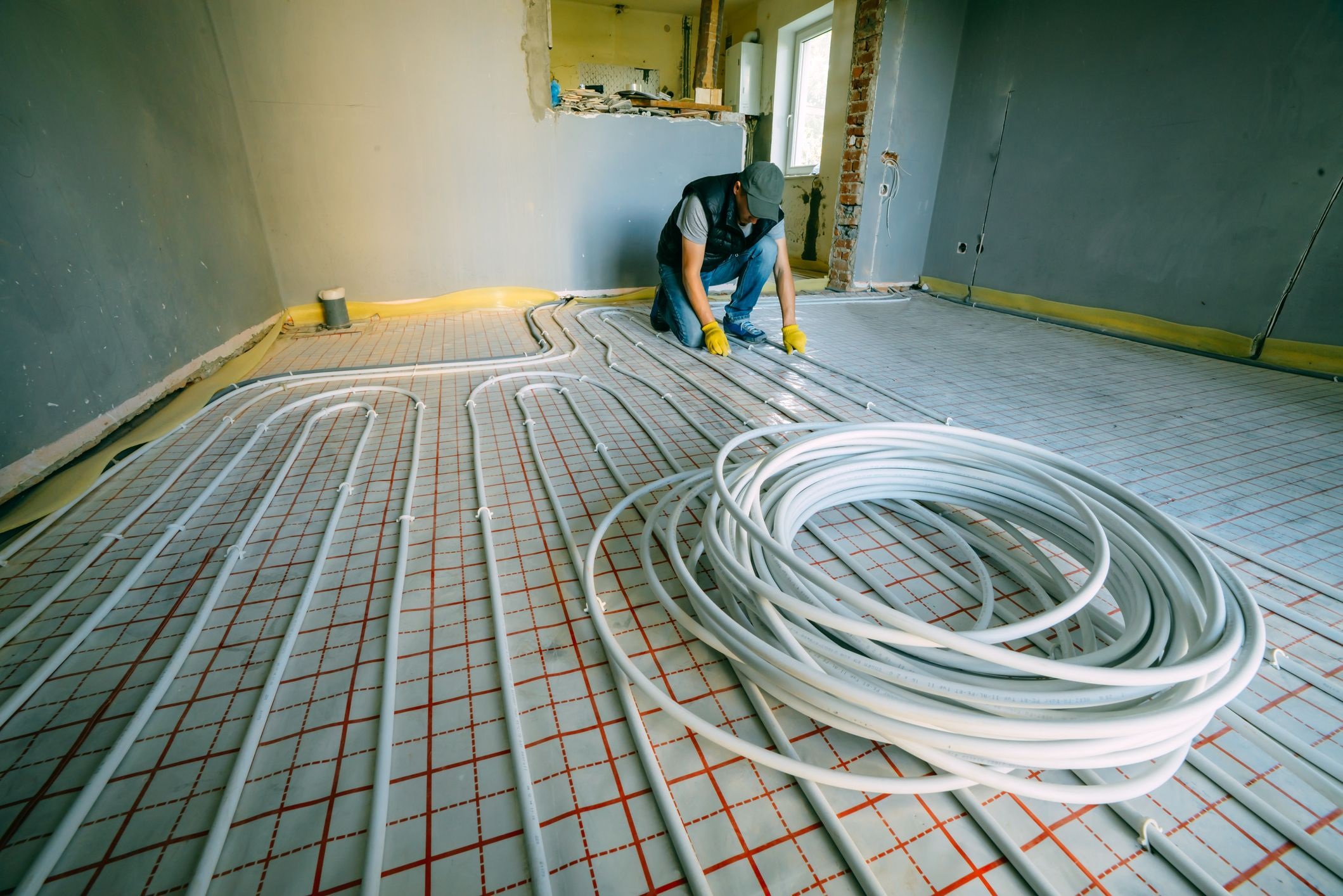
There’s nothing quite like stepping onto a warm floor on a cold morning. That’s the comfort TRM Radiant Floor Heating can bring into your home. But with multiple systems available, figuring out which one’s the right fit for your space can feel overwhelming. This guide is here to make that process a whole lot easier.
Understanding TRM Radiant Floor Heating Systems
What Is a Radiant Floor Heating System?
At its core, radiant floor heating is about comfort. Instead of blowing hot air around, it delivers warmth evenly from the floor up. You get consistent, quiet heat that doesn’t stir up dust or take up wall space. It’s efficient, nearly invisible once installed, and incredibly pleasant in the winter months.
How TRM Electric Floor Heating Works
TRM Radiant Floor Heating systems use electric cables or heating mats that are installed beneath your flooring. When activated, these elements generate heat that radiates upward, warming the room from the ground up. It’s especially effective with hard surfaces like tile or stone, but can be tailored to work with other types of flooring, too.
Why Radiant Heating Is Gaining Ground
People are moving away from noisy, inefficient forced-air systems. Radiant heat offers better coverage, fewer cold spots, and no dust circulation. Plus, once installed, it’s practically maintenance-free. The comfort level is hard to beat, especially in areas like bathrooms and kitchens.
Types of TRM Floor Heating Kits
Cable Kits
If you have an oddly shaped room or want flexibility in layout, a cable kit might be your best bet. These give you control over where the heating elements go and are often embedded directly into thinset mortar before tile is laid.
Mat Kits
Mat kits, on the other hand, are more of a plug-and-play solution. The heating cable is pre-attached to a mesh mat, which makes installation quicker, especially in square or rectangular rooms. It’s a favorite for straightforward renovations where speed and simplicity matter.
Self-Regulating Cables for Outdoor Use
Not all heating needs stop at your doorstep. TRM also offers self-regulating cables for outdoor applications—think snow melting on walkways or preventing ice build-up in gutters. These adjust their heat output based on outdoor temperatures, giving you peace of mind during the winter.
What to Think About Before Choosing a Kit
Room Size and Shape
First things first: measure your space accurately. Only count the areas where people will walk or stand—underneath permanent fixtures like cabinets or tubs doesn’t need heat. The square footage you come up with will determine the size of the kit you need.
Flooring Material
The type of floor you’re working with matters. Tile and stone are ideal since they conduct heat well. Wood or laminate? They can still work, but you’ll need to make sure the system is compatible and that you’re using the correct underlayment to avoid damage from excessive heat.
Subfloor and Insulation
Installing directly over a cold basement or slab? Consider adding insulation boards beneath the heating system. This keeps the heat from being absorbed downward and ensures more of it goes into your living space where it belongs.
Energy Efficiency
A well-insulated system not only heats better but uses less electricity. Choosing a setup with zoning capabilities or smart thermostat control can also make a noticeable difference in long-term energy use.
Matching Kits to Room Types
Bathrooms
Warm bathroom floors are more than just a luxury—they help reduce moisture buildup and improve comfort. A mat kit usually works well in these smaller spaces, and you’ll want a floor sensor thermostat to keep things consistent.
Kitchens
In kitchens, radiant heat is great for keeping the space cozy, especially since tile can be cold underfoot. Cable kits give you flexibility to work around cabinets and islands without wasting materials or heat.
Living Areas
Open-concept spaces benefit from larger heating zones. You might even combine multiple kits with separate thermostats for better control. Just remember to plan around large furniture pieces where heat isn’t needed.
Outdoor Surfaces
For walkways, driveways, or roof edges, a self-regulating TRM cable can make a world of difference in winter. These systems kick in when temperatures drop and automatically scale back when it’s warmer, saving energy and preventing hazards.
Choosing the Right Voltage and Power
120V vs. 240V
Both voltages perform similarly, but the size of the area you’re heating makes a difference. For rooms under 150 square feet, 120V is typically fine. For anything larger, 240V is more efficient and requires less current, which puts less strain on your home’s electrical system.
Figuring Out Wattage
To estimate wattage, take your heated square footage and multiply by the system’s output per square foot (often around 12 to 15 watts). This gives you a ballpark of how much energy the system will use and helps you choose the right components.
Thermostat and Control Options
Manual vs. Programmable Thermostats
Manual thermostats are basic but effective. If you prefer to “set it and forget it,” a programmable thermostat is a better choice. You can set it to warm the floor before you wake up and turn off while you’re out, which helps save energy without sacrificing comfort.
Smart Thermostats
Want to control your heating from your phone? Smart thermostats offer remote access, learning features, and real-time energy monitoring. Many are compatible with home automation systems and voice assistants.
Ensuring Compatibility
Whichever thermostat you pick, make sure it’s rated for use with TRM Radiant Floor Heating systems and supports both the voltage and amperage of your chosen kit. Floor temperature sensors are a must for safety and efficiency.
Installation: DIY or Pro?
Can You Install It Yourself?
Many TRM kits are DIY-friendly, especially the mat versions. As long as you’re comfortable with floor prep and following instructions, you can handle most of the job. That said, all electrical connections need to be made by a licensed electrician to stay up to code.
When to Call an Electrician
Wiring the thermostat, connecting to the circuit breaker, and verifying load capacity aren’t things to guess at. Even if you’re handy, having a professional handle the electrical side ensures the system is safe and performs correctly.
Tools and Supplies You’ll Need
Here’s a quick checklist:
-
Multimeter (for testing resistance)
-
Trowel and mortar (for tile jobs)
-
Floor sensor and thermostat
-
Insulation boards (if needed)
-
Tape measure and layout guide
-
Voltage tester
Maintenance and Troubleshooting
Common Problems
While rare, issues like cold spots or thermostat malfunctions can happen. Often, these are due to incorrect sensor placement or installation errors. Testing the system before final floor installation helps catch problems early.
Keeping the System Running Smoothly
Once in place, TRM Radiant Floor Heating systems are largely maintenance-free. Periodic checks with a multimeter can confirm everything is functioning as it should. Keep thermostats updated and avoid drilling or nailing into the floor without checking the cable layout.
Environmental Considerations
Eco-Friendliness
Electric radiant systems are clean and efficient, producing no on-site emissions. If you’re powering your home with renewable energy, the footprint is even smaller. Unlike gas or oil systems, there’s no combustion, making it a greener option overall.
Reducing Energy Use
Using insulation, zoning, and smart controls can dramatically reduce power consumption. Heat only the spaces you use and avoid running the system 24/7. With proper planning, you’ll get maximum comfort for minimal energy use.
Where to Buy TRM Floor Heating Kits
When shopping, look for reputable suppliers that offer certified TRM kits and full technical documentation. Pay attention to warranty information and check that the kit includes everything you need for your specific room size and floor type.
Conclusion: Making the Right Choice
Choosing the right TRM Radiant Floor Heating kit is all about understanding your space, your needs, and your home’s layout. Whether it’s a cozy bathroom, a spacious living area, or an icy walkway outside, there’s a TRM solution that fits. With the right prep and planning, you’ll enjoy warm, efficient comfort that lasts for years to come.
Key Takeaways
-
TRM Radiant Floor Heating offers consistent, quiet, and efficient warmth across a variety of spaces
-
Select between cable kits, mat kits, or self-regulating cables depending on room layout and surface type
-
Proper measurements, insulation, and thermostat pairing are essential for optimal performance
-
DIY installation is possible, but electrical work should always be left to a licensed pro
-
Smart controls and good insulation significantly improve energy savings and comfort
Frequently Asked Questions
How long does installation take?
Most installations take a few hours to a day, depending on the room size and whether you’re using a mat or cable system. Drying times for mortar or self-leveler may add extra time before the floor can be used.
Can radiant heat be used under wood or laminate floors?
Yes, as long as the system and flooring are compatible. You’ll need to follow manufacturer guidelines for maximum temperatures and use an appropriate underlayment.
What’s the expected lifespan of the system?
A properly installed TRM system can last 20 years or more. The heating cables or mats are durable and require little to no maintenance once installed.
Is it safe for pets and kids?
Definitely. Since there are no exposed hot surfaces and the heat is gentle and consistent, it’s a safe and comfortable option for everyone in the home.
How do I calculate the size of the kit I need?
Measure the open floor space (excluding built-ins and permanent fixtures), and choose a kit that closely matches that area. Avoid overlapping heating cables or mats, and always follow spacing guidelines.








